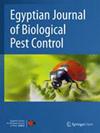秋粘虫卵层数和鳞片厚度对双歧赤眼蜂(膜翅目:赤眼蜂科)寄生性能的影响
IF 2.1
3区 农林科学
Q1 ENTOMOLOGY
引用次数: 0
摘要
摘要背景秋粘虫(FAW),又称Spodoptera frugiperda (J. E. Smith)(鳞翅目:夜蛾科),是危害玉米等350种经济作物的新型外来有害生物之一。大多数农民仍然依赖化学杀虫剂来抑制害虫,但frugiperda已成功地对大多数化学科产生抗药性。强烈建议改进有效的环保方法。因此,卵类寄生蜂由于其幼虫的摄食行为,是控制卵早期FAW的最佳武器。在这方面,本研究评估了作为物理屏障的一叶赤眼蜂的卵层和鳞片厚度在非选择和选择试验中对卵类寄生蜂赤眼蜂(Trichogrammatoidea bactrae Nagaraja,膜翅目:赤眼蜂科)寄生性能的影响。此外,根据寄生率、成虫羽化率和雌蜂子代数,测定了一虫产成蜂对下一代的影响。结果两种试验结果均表明,乳杆菌均能寄生于所有暴露的一汽虫卵群中,但寄生率随卵层数和鳞片厚度的不同而不同。1层(83.18、78.24%)和2层(65.99、76.42%)的寄生率最高,3层(42.15、46.05%)的寄生率最低。10 ~ 12天后,所有被试虫卵均有较高的出虫率(~ 88 ~ 98%),且两种试验的子代均以雌偏为主。此外,f1后代的寄生性能与亲代相似,在所有暴露的卵群中,寄生率高(~ 87 ~ 95%),雌性偏向性强(~ 68 ~ 76%)。结论卵类拟寄生蜂具有较强的抗虫层数和鳞片厚度的能力,可作为一种有效的防虫剂推荐使用。本文章由计算机程序翻译,如有差异,请以英文原文为准。
Impact of egg mass layers and scale thicknesses of the fall armyworm, Spodoptera frugiperda (Lepidoptera: Noctuidae), on the parasitic performance of Trichogrammatoidea bactrae (Hymenoptera: Trichogrammatidae)
Abstract Background Fall armyworm (FAW), Spodoptera frugiperda (J. E. Smith) (Lepidoptera: Noctuidae), is one of the new alien destructive pests of maize and other 350 economic crops. The majority of farmers are still depended upon chemical insecticides to suppress the pest, but S. frugiperda has succeeded to develop resistance against most of the chemical families. Improving an effective environmentally-friendly approach is highly recommended. Therefore, the egg parasitoids are the best weapon for managing the FAW in the early egg stage due to the feeding behavior of their larvae. In this regard, the impact of FAW egg mass layers and scale thicknesses, as physical barriers, on the parasitic performance of the egg-parasitoid species, Trichogrammatoidea bactrae Nagaraja (Hymenoptera: Trichogrammatidae), in non-choice and choice tests was assessed. Besides, the efficacy of FAW-produced adult wasps on the next generation based on the rates of parasitism, adults' emergence, and female progeny was determined. Results Obtained results exhibited that T. bactrae was able to parasitize all exposed FAW egg masses but with different rates related to the layers’ number and scales' thicknesses in both tests. One-layer (83.18, 78.24%) and two-layer egg masses (65.99, 76.42%) had significantly the highest parasitism rate, while three layers (42.15, 46.05%) was the least one, in both tests, respectively. All parasitoids emerged after 10–12 days with high rates (~ 88–98%) from all the tested egg masses, and the majority offspring were female-biased in both tests. Furthermore, parasitic performance in F 1 progeny was similar with that recorded in parental generation in terms of parasitism rate, high parasitoid emergency (~ 87–95%), and strongly female-biased (~ 68–76%) in all the exposed egg masses. Conclusions The egg parasitoid, T. bactrae, could be an efficient and recommended bio-control agent against FAW as its greatest ability to overcome the layers’ number and scales’ thickness.
求助全文
通过发布文献求助,成功后即可免费获取论文全文。
去求助
来源期刊
CiteScore
4.90
自引率
16.70%
发文量
128
审稿时长
>12 weeks
期刊介绍:
The Egyptian Journal of Biological Pest Control is a periodic scientific journal published by the Egyptian Society for Biological Control of Pests (ESBCP) in collaboration with SpringerNature. The journal aims to publish internationally peer-reviewed, high-quality research articles in the field of biological and integrated pest control (non-chemical control). The journal publishes review articles, original papers, conference reports, book reviews, editorials, laboratory reports, technical notes and short communications.

 求助内容:
求助内容: 应助结果提醒方式:
应助结果提醒方式:


